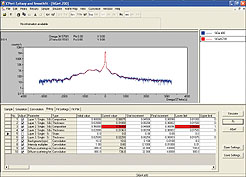Jul 26 2007
PANalytical’s new X’Pert Epitaxy and Smoothfit software version 4.2 allows the detailed analysis of semiconductor epitaxial layers using the company’s X’Pert PRO MRD and earlier high-resolution X-ray diffractometers. The package is part of PANalytical’s X’Pert software range that uses XRDML formatting.
 XRD analysis using PANalytical's X’Pert Epitaxy and Smoothfit software version 4.2.
XRD analysis using PANalytical's X’Pert Epitaxy and Smoothfit software version 4.2.
When analyzing semiconductor epitaxial layers, obtaining a good fit of simulation to data can be a challenge. X’Pert Epitaxy and Smoothfit automatically fits simulated rocking curves to measurement data. It offers five different algorithms and can be tailored for unique fitting requirements. Default fitting parameters for all algorithms allow ‘quick start’ use of the software and as experience builds, algorithms can be selected as required.
Users can choose from the following algorithms: Smoothfit, which controls adjustment parameters and obtains a measure of precision; Levenberg-Marquardt for automatic adjustment calculation; Principal Axis for a true statistical sweep of parameter space; Genetic Algorithm, a global optimization technique for starting parameter values of low confidence levels; and Simulated Annealing, which avoids local minima problems.
A streamlined fitting tab shows the live status of all parameters being fitted. On completion any parameter approaching upper or lower limits will be highlighted, allowing users the option to re-fit with extended parameters where appropriate.